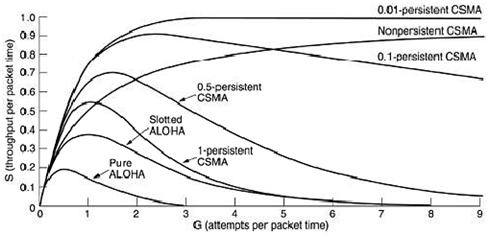(i) 1-persistance CSMA
(ii) Non-persistence CSMA
(iii) P-persistence CSMA.
Carrier Sense Multiple Access Protocols:
With the slotted ALOHA the best channel utilization which can be attained is 1/e. This is hardly surprising, since with stations transmitting at will, without giving attention to what the other stations are doing, there are bound to be number of collisions. In local area networks, here it is possible for stations to detect what other stations are performing, and adapt their behaviour according to that. These networks can achieve a much improved utilization than 1/e. In this segment we will discuss some protocols for improving the performance and efficiency of the system. Protocols in which the stations listen for a carrier (i.e., a transmission) and act according to that are called carrier sense protocols. Many number of which have been proposed. Kleinrock and Tobagi (1975) have analysed many such protocols in detail. Below we will mention many versions of the carrier sense protocols.
Persistent CSMA:
The first carrier sense protocol which we will study here is known as 1-persistent CSMA (Carrier Sense Multiple Access). When a station in containing some data to send, it primary listens to the channel to see if anyone else is transmitting at that particular moment. If the channel is engaged, the station waits until it becomes free. When the station detects an idle channel, it transmits the frame. If a collision happens, the station waits for some random amount of time and starts all over again. The protocol is known as 1- persistent because the station transmits with a probability of 1 when it finds the channel free. The propagation delay has a significant effect on the performance of the protocol.
There is a small chance that just after a station starts sending, another station will automatically become ready to send and sense the channel. If the first station's signal has not yet reached the next one, the latter will sense an free channel and will also start sending, resulting in a collision. The longer the propagation delay, the more significant this effect becomes, and the worse the performance of the system.
Even if the propagation delay is seen zero, there will still be some collisions. If two stations become ready in the middle of a other station's transmission, both will wait politely until the transmission finishes and then both will start transmitting exactly simultaneously, resulting in a collision. If they were not so impatient, there would be less number of collisions. Even so, this protocol is far improved than pure ALOHA because both the stations possesses the decency to desist from interfering with the other station's frame. Intuitively, this approach will lead to a good performance than pure ALOHA. Accurately the same holds for slotted ALOHA.
Non-persistent CSMA:
The second carrier sense protocol is the non-persistent CSMA. In this protocol, a continuous attempt is made to be less greedy than in the last one. Before sending, a station senses the channel properly. If no one is sending, the station starts doing so itself. But if the channel is already in use, the station does not repeatedly sense it for the purpose of seizing it immediately upon detecting the end of the last transmission. Instead, it waits a random time period and then repeats the algorithm. Consequently, this algorithm leads to improved channel utilization but longer delays than 1-persistent CSMA.
P-persistent CSMA:
The last remaining protocol is p-persistent CSMA. It applies to slotted channels and works as shown below.
When a station becomes ready to send the data, it senses the channel. If it is free, it transmits with a probability p. With a probability q = 1 - p, it varies until the next slot. If that slot is also free, It either transmits or varies again, with probabilities p and q. This process is frequent until either the frame has been transmitted the information or another station has begun transmitting the information. In the latter case, the unlucky station behaves as if there had been a collision (i.e., it waits a random time and starts again for sensing if the channel is free). If the station initially senses the channel engaged, it waits until the next slot and applies the above written algorithm. Figure 4 shows the computed throughput versus offered traffic for all the three protocols, as well as for both pure and slotted ALOHA.
